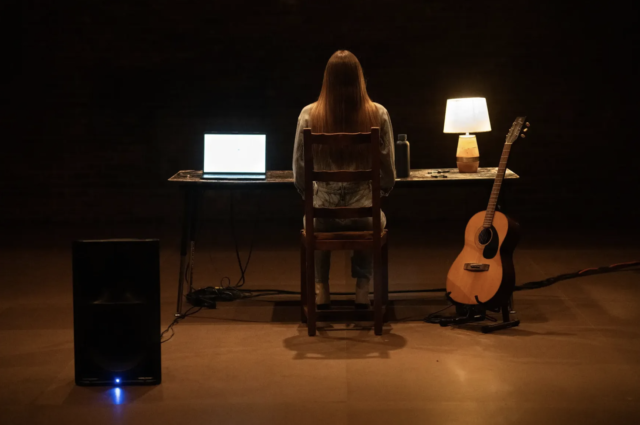
Mona Pirnot sits with her back to the audience throughout I Love You So Much I Could Die (photo by Jenny Anderson)
I LOVE YOU SO MUCH I COULD DIE
New York Theatre Workshop
79 East Fourth St. between Second & Third Aves.
Monday – Saturday through March 9, $65-$75
www.nytw.org
Almost forty years ago, I composed a eulogy for my father’s funeral but was unable to read it because I was too distraught; instead, one of my best friends read it for me. So I understand why Mona Pirnot performs her solo show, I Love You So Much I Could Die, about a family tragedy with her back to the audience and has a Microsoft text-to-speech tool read her story, interspersed with five songs she sings with an acoustic guitar without turning around. However, I’m not convinced that it’s the best way to share this specific narrative, which doesn’t live up to the technical aspects of the production.
The play starts with Pirnot walking down one of the aisles and onto Mimi Lien’s spare set, where she takes a seat on a ladderback chair at a folding table with a laptop, a water bottle, a microphone, and a lamp; a floor speaker and monitor are nearby. She opens the computer and pushes the space bar; a disconcerting, disembodied male AI voice begins, “I’ve been trying out different support groups. It has not been going well. I can’t seem to find the right group for me. And everything is on zoom. Which makes everything sadder than it already was. And everything was already sad.” The voice adds a moment later, “[The leader] asked if I wanted to share first. I did not. But I said okay. I shared my story and when I was done, the guy was like, oh my god that’s awful. And I was like, yep. And he was like, oh my god. And I was like . . . yeah.”
As the voice recites the text, audience members with sharp eyesight can follow along as each word is highlighted on the screen as it’s spoken, reminiscent of karaoke, especially when the amateur warbler might be a bit tipsy and/or tone deaf. The delivery is bumpy, with unexpected pauses and mispronunciations, particularly involving the name Shia LaBeouf.
Pirnot, wearing a comfortable jumpsuit (the costume is by Enver Chakartash), stops the program five times to perform melancholic songs, including “happy birthday whatever who cares,” “good time girl,” and “Home to You.” The tunes are slow, mournful, and self-deprecating; she introduces “good time girl” by explaining it is much better with a hardcore electric guitar solo, which she instead will perform with her mouth, and proceeds to sing, “I fell back into that hole I forgot was there / My ride drove off and left me in the middle of nowhere / mmm I’m gone / Don’t even know where I went.”
The story also goes back ten years, when Pirnot first met a playwright who “would later become quite famous. As famous as a playwright can get ha ha if playwrights can ever really get famous.” Although she never mentions him by name, it is the man she would eventually marry, Lucas Hnath, who has written such plays as Red Speedo, The Christians, A Doll’s House Part 2, and The Thin Place. Hnath is the director of I Love You So Much I Could Die and has noted in interviews that one of the reasons he opted for Pirnot to sit with her back to the audience because that is how he saw her when she was writing the piece. For added intimacy, the lamp on the table is from their home.
I Love You So Much I Could Die is part of an unofficial trilogy (with maybe more to come?) in which Hnath explores unique methods to tell stories using old and new sound technology in one-person shows. In Dana H., Deirdre O’Connell won a Tony without speaking a word, instead lip-synching to an interview Hnath’s mother gave about her abduction by a member of the Aryan Brotherhood. In A Simulacram, actor, magician, and illusion designer Steve Cuiffo discusses his life and career by using an in-ear device to communicate live with a cassette recording of Hnath, re-creating exact conversations they had over the course of more than fifty hours of workshopping.
Dana H. and A Simulacram were both fascinating plays with compelling, entertaining stories to tell; unfortunately, I Love You So Much I Could Die falls short in that respect. Perhaps Hnath is too close to this one; the play might be a great way for Pirnot (Private, the world is full on) to deal with her personal situation, but it’s not an unusual one, even though she does not give specific details of what happened. In addition, the final section feels manipulative, tossed in to elicit a last surge of emotional melodrama.
While the AI’s voice is clear and crisp, it is often difficult to make out everything Pirnot is singing in her slow, eerily quiet tunes. (The sound design is by Mikhail Fiksel, with music direction by Will Butler.) Throughout the play’s sixty-five minutes, Oona Curley’s lighting dims nearly imperceptibly throughout the theater, ending in complete darkness.
I was hoping that at the conclusion, Pirnot would get off the chair and make her way to the door at the back left of the theater, never showing herself to the audience, but instead she turned around and smiled as she bowed. It’s not that didn’t deserve applause, but I thought it was a lost opportunity to add a special coda to this very private play.
[Mark Rifkin is a Brooklyn-born, Manhattan-based writer and editor; you can follow him on Substack here.]